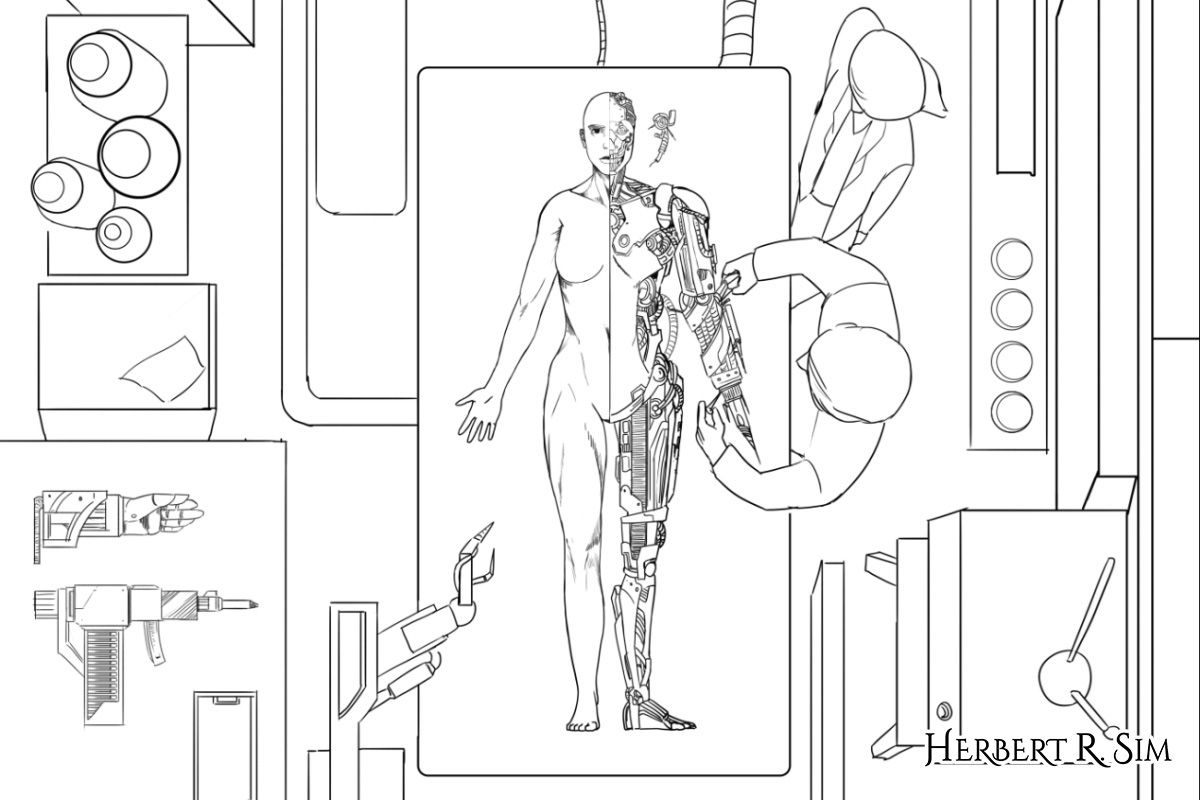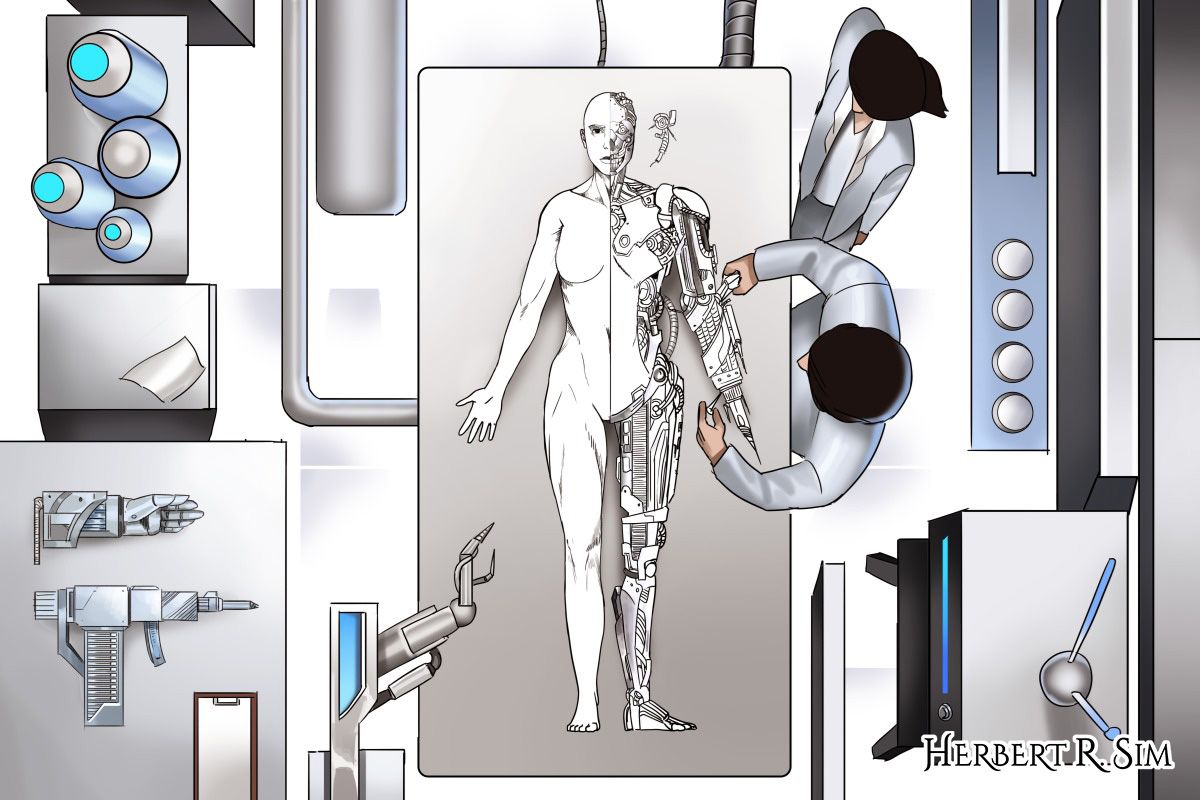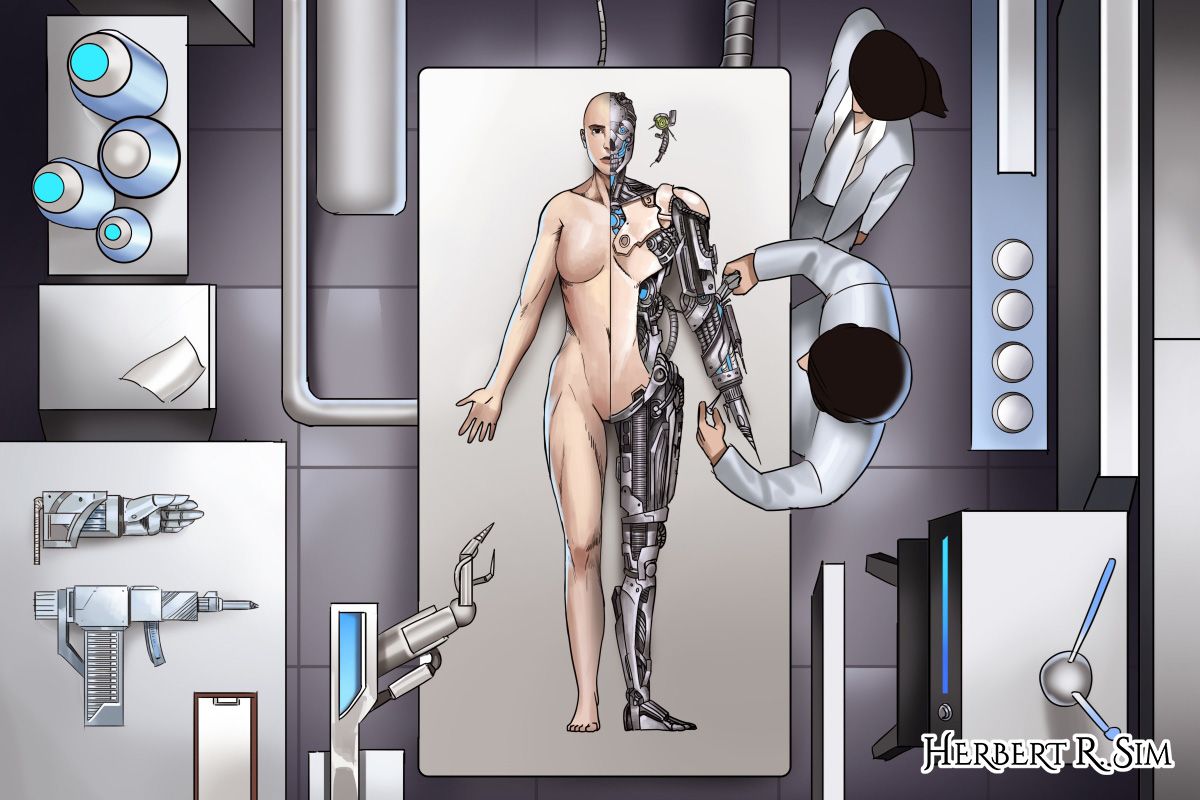
In my illustration of Transhumanism, I sketched a half-human half-robot being, which could also possibly be a full robot masked as a human, or a human, enhanced with robotics. The art concept is inspired by The Bionic Woman.
————————————————————-
In modern society, we’re often taught to push past our limits, to place mind over body and seek ways to improve every aspect of our lives. Of course, there are myriad perspectives and discourses that people are fighting for – albeit with the same goal of seeking vast improvement – whether in terms of one’s physical ability, mental wellness, or overall health status.
Previously, we discussed the topic on cloning, the technology behind it and its potential to become a platform for further genetic efforts to give humans the advantage, for example, to overcome physical limitations. In this piece, we naturally shift our focus onto the concept and movement that is transhumanism, which over time has also become a key driver to help proponents achieve the goal of being “more than just human”.
Transhumanism constantly seeks the use of technology and science to enhance human physical and mental capabilities. Essentially, the goal of transhumanism is to extend human life and improve the human condition by using cutting-edge technologies such as biotechnology, genetics, and artificial intelligence.
In essence, to transcend human capabilities, to have powers and abilities beyond those of standard humans.
David Pearce, a British philosopher and one of the key figures in the transhumanist movement, introduced the concept of the “abolitionist project” that aims to eliminate suffering in all forms by using technology and science.
Of drugs and chemistry
He has raised the idea of using designer drugs to affect brain chemistry and eliminate the root causes of mental suffering, such as depression, anxiety, and psychoses. In a way, these designer drugs will enable one to step into a world void of mental suffering, a seemingly quickfire treatment that yields results quicker than current progressive methods. It’s akin to trumping human weakness and finding that cheat code to program sanity.
Psychosis, by definition, describes a mental state that is characterised by a loss of contact with reality. People who are experiencing psychosis may showcase symptoms such as hallucinations and disordered thinking. Schizophrenia, for example, is a type of psychotic disorder than can be treated with antipsychotic drugs such as chlorpromazine, first introduced in the 1950s and is still used today.
To put it simply, antipsychotic drugs work by blocking the action of neurotransmitters in the brain, such as dopamine, which are perceived to be involved in the development of psychotic symptoms. Apart from helping to reduce the severity of such symptoms, antipsychotic drugs can also enhance overall functioning as well as heighten a person’s recovery from a psychotic episode.
Gene-editing: Trying to play god?
A movement can only gather steam and achieve its goals when breakthroughs are made, and tangible results are recorded. This can be seen in another slice of the transhumanist pie where the movement has clocked significant interest and, in this case, it’s the realm of genetics.
With the relative success of the Human Genome Project, scientists have uncovered the ability to edit human DNA and treat genetic disorders. For example, CRISPR-Cas9 made headlines as a revolutionary gene-editing technology that has already been tapped to cure genetic diseases in animals.
Moreover, researchers are also exploring the use of gene therapy and an emerging biotechnology revolution to treat cancer and other diseases. Transhumanists, in a way, endeavour to use advances in genetics to conceive a future whereby people can be born with perfect health, coming into the world free from genetic disorders.
Genetic engineering, for some time, has been used extensively in agriculture, primarily to conceive genetically modified (GM) crops (also known as GMO –genetically modified organisms). These crops are designed to be resistant to herbicides and pesticides, which means they are also immune to the chemicals that farmers use to eradicate weeds and insects. They are also perceived to have greater yields of nutritional value, and such methods can be used in the selective breeding of farm stock, race horses and show animals.
Similarly, such a modification concept is thought to be in line with what can be done for humans, where genetically engineered bacteria, for example, is being used to produce human insulin and other pharmaceuticals.
The core argument is that genetic engineering can enhance the characteristics that humans want, including the likes of intelligence, beauty, strength and even endurance. Advocates of genetic engineering point out that such traits can be achieved through diet, exercise, and education, but as will be uncovered, science and technological breakthroughs can also accelerate such a process.
————————————————————-

In the future, I believe that robotic prosthetics will be available readily, and being able to be controlled with a computer chip (neurochip) embedded in one’s head.
————————————————————-
Marrying science and technology
The idea of human life as being fragile and brittle is something that transhumanists aim to negate. They believe that advancements in technology can greatly improve human life. For example, heart rate monitor rings and the OSIM iGallop core and abs exerciser are examples of how there’s a constant push to monitor and improve one’s physical health.
The use of artificial intelligence (AI) also comes into mind for transhumanist efforts, including Microsoft’s new ClearFlow traffic maps and the driverless robotic cars created by Stanford teams for competitions – sponsored by the Defense Advanced Research Projects Agency. Transhumanists believe that these technologies have the potential to dramatically improve human life by allowing us to overcome physical limitations, improve our cognitive abilities, and extend our lifespans.
At times, it is thought that technology and science, while seemingly intertwined, is difficult to meld together to create a cohesive piece of product. This is due to the varying levels of development and advancement stages in both spheres of technology and science research – where one could be ahead of another.
However, when technology and science do come together as one, it is recorded as a triumph in the books of transhumanists, such as the development of prosthetic limbs. The advancement in robotics and materials science research has enabled the creation of prosthetics that are not only functional but also look and feel like natural limbs. Better yet, scientists have developed brain-machine interfaces that allow prosthetic users to control their limbs using only their thoughts. Significantly, this technology has changed the lives of millions of people and demonstrates how powerful the potential of technology and science can be when coaxed together for the betterment of humanity.
Essentially, transhumanists believe that by working together, technology and science can be used to create a future in which everyone has access to better health, longer life, and enhanced mental and physical capabilities. Such a future is extremely appealing for transhumanists, where people are free from the constraints of their bodies and can pursue goals and aspirations without limitations. The slogans that famous sports brands carry, the inspirational quotes that we often read and try to motivate ourselves with, these are no longer just mere words that drive us – as we can achieve said results through tangible solutions.
Ultimately, transhumanism aims to abolish suffering through the effective use of technology and science. The seeking of such, however, remains to be seen as developments abound and evolve, where breakthroughs are needed to normalise the movement’s existence, to make plausible transhumanism’s role in today’s reality. All of these, as we answer questions posed by naysayers and detractors.
————————————————————-

